Cable machines are a good choice if you want simple and effective gym equipment to train your back muscles.
Cable back workouts are a great alternative for people who experience joint discomfort during barbell rowing.
The cable machine workout can train all the major and minor muscles in your back with different attachments, angles, and weights.
They provide a constant load that promotes smooth and controlled movement and maximizes the time under tension.
In this guide, I’m sharing my 20 favorite (based on science and experience) back cable exercises.
Want to take your gains to the next level? Discover your daily calorie needs with our free TDEE calculator
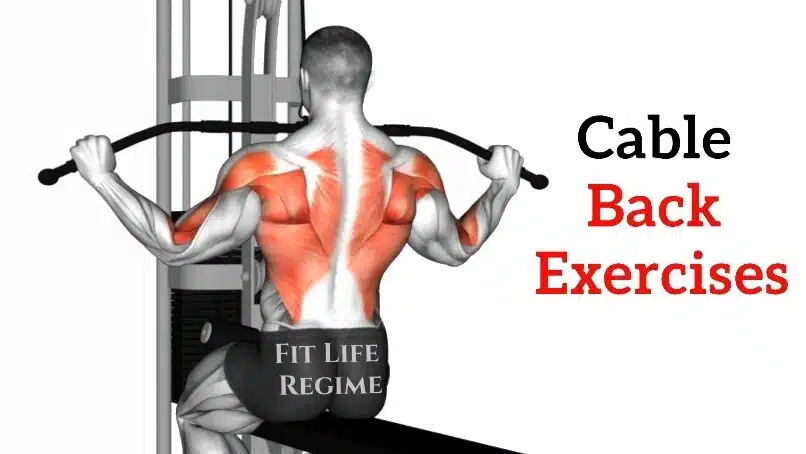
- 20 Best Cable Machines Back Exercises
- 1. Lat Pulldown
- 2. One-Arm Lat Pulldown
- 3. Seated Cable Rows
- 4. Wide Grip Seated Row
- 5. Straight Arm Lat Pulldown
- 6. V Bar Lat Pulldown
- 7. Straight Arm Rope Pulldown
- 8. Incline Straight Arm Pulldown
- 9. Double cable neutral-grip lat pulldown
- 10. Seated One Arm Cable Row
- 11. Cable Twisting Standing Row
- 12. Bent Over One Arm Cable Pull
- 13. Cable Upright Row
- 14. Cable Shrug
- 15. Cable Pullover
- 16. Cable High Row
- 17. Reverse Cable Crossover
- 18. Face Pull
- 19. Low Cable Row
- 20. Cable Deadlift
- Complete Back workout with Cable
- Cable Machine Back Exercises (With Workout Routines)
- 1. Weekly Training Sets
- 2. Select Reps Range Based On Fitness Goals
- Beginner Back Workout Routine
- Intermediate Back Cable Workout Plan
- Advance Back Workout plan
- Back Anatomy
- Are cable exercises good for back training?
- References
20 Best Cable Machines Back Exercises
Try cable back exercises to increase your strength and muscle mass. They help you work your back muscles evenly and keep them working constantly.
Here are the 20 best cable machine exercises to strengthen your upper, middle, and lower back.
1. Lat Pulldown
If you’re looking for a straightforward cable machine exercise to add to your back workout routine, then lat pulldown is a great starting point.
The Lat pulldown is a popular compound exercise that targets and strengthens the upper back muscles, particularly the latissimus dorsi. To some extent, the exercise also engages other muscles, including the biceps, rear delt, trapezius, and shoulders.
The exercise is easy to learn and very effective at building back strength.
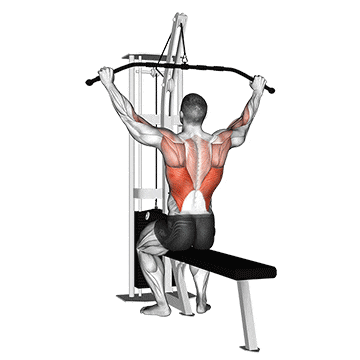
How To Do
- Grip the bar with an overhand grip, hands slightly wider than shoulder-width apart.
- Lock your knees under the support pads.
- Keep your upper back straight, pull the bar down, and bring it up to the chest.
- As you pull down, squeeze your shoulder blades together and feel your back muscles contracting.
- Perform this movement using your upper back and use the arms merely as a lever between the bar and lats.
- Now, release the bar with controlled motion and stretch your lats as much as possible.
- Go full range of motion and concentrate on your back muscles doing the major work.
2. One-Arm Lat Pulldown
The one-arm lat pull-down is a unilateral exercise that primarily targets the latissimus dorsi, commonly known as the lats.
It is helpful to perform the exercise unilaterally to identify and address any muscular imbalances between the left and right sides of the back.
I believe it promotes equal development and enhances overall strength and stability.
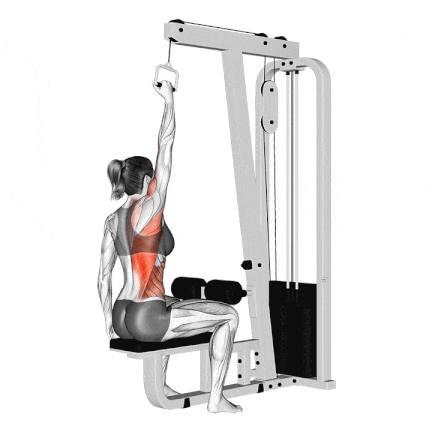
How To Do
- Attach a D-handle and grasp it with one hand while extending your arm overhead.
- Pull the handle down and back towards the side of your torso.
- Focus on squeezing your lat muscle to achieve a strong contraction.
- Slowly return the handle to the starting position.
- Perform the desired repetitions on one side before switching to the other arm.
3. Seated Cable Rows
Seated Cable Rows are an excellent cable exercise for building middle back muscles, and they also work on the lower back.
It’s incredibly versatile. You can easily switch up your grip or the attachment you’re using. Want to target your lats more? Go for a wide grip. Looking to hit those rhomboids? Try a close grip. It’s like having multiple exercises in one!
You could also try different grips to train the lats, but shift your focus to other muscles.
- A pronated (overhand) grip also targets the upper and middle trapezius and the rhomboids.
- A neutral (thumbs up) grip effectively hits the middle and lower trapezius and rhomboids.
- The supinated (underhand) grip switches the focus to the latissimus dorsi and also involves the biceps to a greater extent.
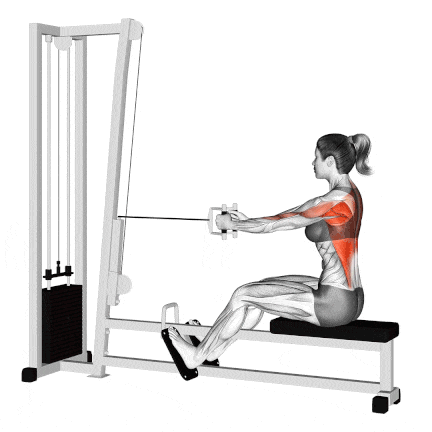
How To Do
- Sit on a seated cable pulley rowing machine with legs bent and feet supported against the crossbar.
- Take hold of the handles with your arms extended and back stretched.
- Remember, a rounded back is a wrong back. Keep it straight at all times.
- Pull the handles to come as close to the abdomen as possible.
- Thrust your chest out while pulling with your body in an upright position.
- Slowly return the handle to the starting position.
- Keep your upper back stationary; don’t move your upper back, back and forth.
4. Wide Grip Seated Row
The seated row is normally done with a narrow grip, but if you’d like to focus on the wider back, you can use a wide grip.
Wide-grip rows can thicken your back because the muscles in your upper back do most of the work. They effectively target the back muscles, including the latissimus dorsi, rhomboids, and trapezius.
To do it correctly, be sure the movement is slow and fluid – no jerking or raising yourself up to push down with your body weight.
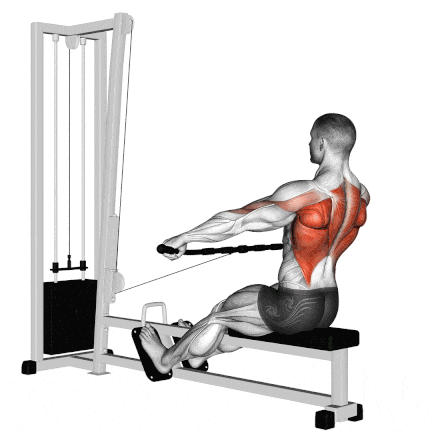
How To Do
- Sit on a seated cable pulley rowing machine with legs slightly bent and feet supported against the crossbar.
- Hold the bar with your arms slightly wider than shoulder-width apart.
- Pull the bar so that they come as close to the lower chest as possible.
- Pause briefly when the handles are close abs and squeeze your upper back muscles, bringing the scapulae closer.
- Slowly return the handle to the starting position.
- To fully activate your muscles, perform each rep slowly. Avoid rapid and jerky movements.
5. Straight Arm Lat Pulldown
The straight arm lat pulldown is one of the best cable exercises for strengthening your lats (back). This isolation exercise can also help improve your posture and build a bigger back.
The exercise will primarily target the lats, but you will also notice a fair number of biceps activations. This is a great cable exercise that can really help you widen your upper back.
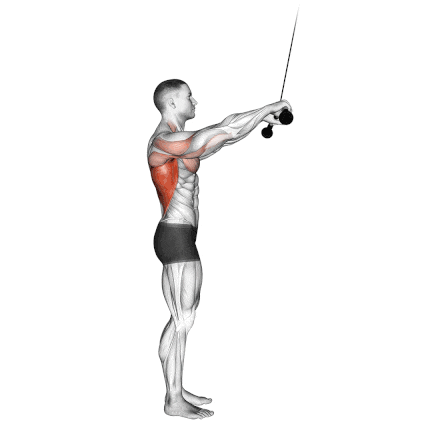
How To Do
- Take an overhand grip that is wider than shoulder-width on a lat bar attached to the pulley on the lat pulldown bar.
- Position yourself with your feet flat on the floor, chest up, and low-back arch exaggerated.
- Keep your elbows slightly flexed and your body still. Don’t allow the head to jut forward as you pull.
- Pull your shoulder blades together as you squeeze your back to initiate the movement, pulling the bar down smoothly to your midsection.
- Hold the contraction for a moment, then slowly return the bar to its starting position.
6. V Bar Lat Pulldown
The V-bar lat pulldown is a compound exercise that targets the latissimus dorsi muscles. Bodybuilders and powerlifters often use it to build strength and muscle mass in the back.
It will primarily target the back, you will also notice a fair amount of bicep and middle back activation.
The back is a muscle group that requires some variation. So, to maximize back muscle growth, experiment with several different angles and hand positions.
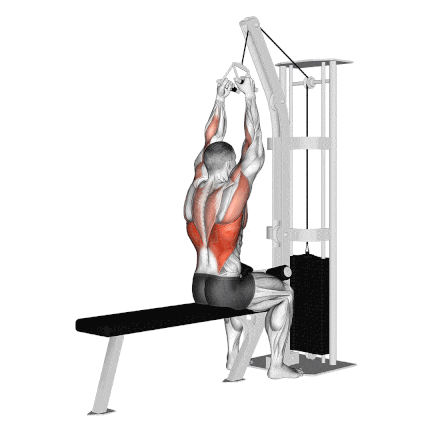
How To Do
- Attach a V handle to the high pulley of a lat-pulldown station.
- Grab the handles with your palms facing each other.
- Keep your upper back straight, pull the V handle down and bring it up to the chest.
- As you pull down, squeeze your shoulder blades together and feel your back muscles contracting.
- Perform this movement using your upper back and use the arms merely as a lever between the handle and lats.
- Now, release the bar with controlled motion and stretch your lats as much as possible.
7. Straight Arm Rope Pulldown
One of my favorite cable back exercises is the straight arm rope pull-down. It is a compound exercise that mainly works the lats and upper back and shoulders.
It uses a rope attachment to give the beginner a more neutral hand position. This can help relieve joint stress some people may get from using other variations.
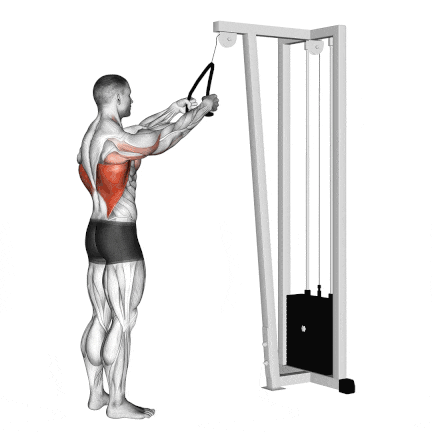
How To Do
- Attach a cable at the highest point at one end of a cable frame.
- Grasp the rope with a neutral grip (palms facing).
- Keep your back straight, chest up, and shoulder blades retracted.
- Keep your back straight (neutral position) to engage the proper muscles and protect your lower back and neck.
- Pull your shoulder blades together as you squeeze your lats to initiate the movement. And then pull the rope down toward your thigh.
- Hold the contraction for a moment.
- Then, slowly return the bar back to the starting position.
8. Incline Straight Arm Pulldown
It’s highly recommended to include the incline straight-arm pull-down in your cable back workout routine for maximum growth and strength development.
It is a very effective cable exercise for building muscle and strength in the back.
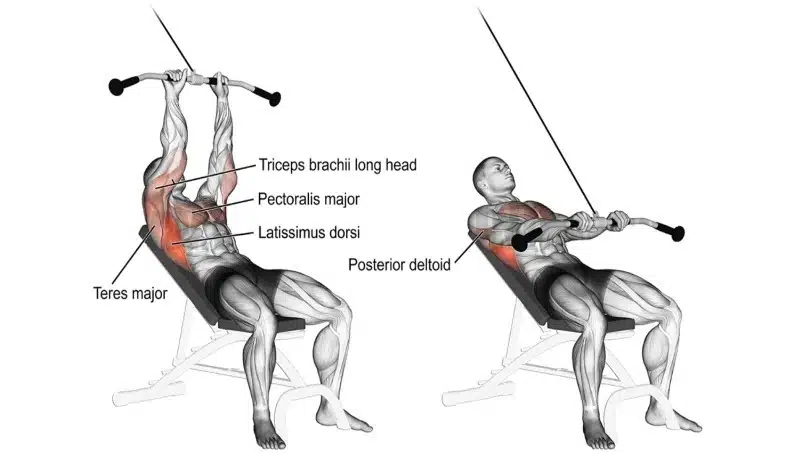
How To Do
- Place an incline bench near the one high pulley.
- Attach a bar grip to a high point on the cable machine.
- Take an overhand grip that is shoulder-width on a lat bar attached.
- Laying down on the bench and position your feet flat on the floor.
- Keep your arms straight to really activate the lats during the movement.
- Pull the bar down as far as you can in a semicircle motion while contracting your lats.
- For a moment, hold the contraction, then slowly return the bar to the starting position.
9. Double cable neutral-grip lat pulldown
The two-arm cable exercise is a brilliant way to build back and arm muscles and develop upper-body strength.
The neutral grip lat pulldown promotes the full range of motion of the lats. Concentrate on squeezing your back muscles at the bottom of the movement.
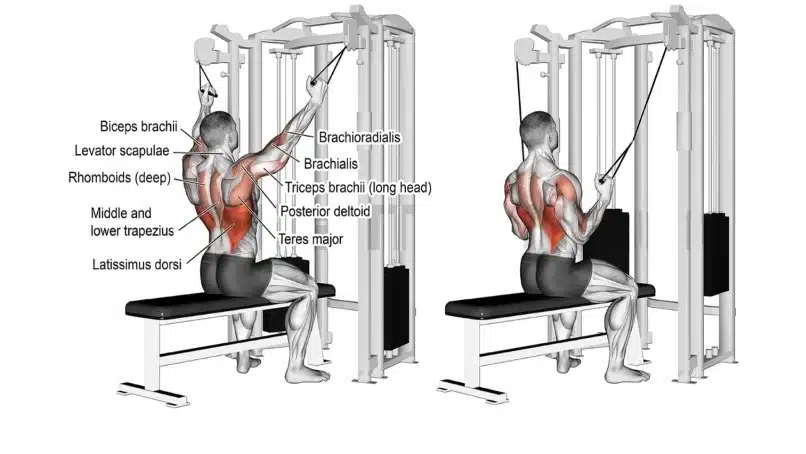
How To Do
- Attach a handle to two high cable pulleys.
- Position a bench or chair midway between the two pulleys.
- Grasp a handle in each hand and sit directly under the pulleys.
- Your arms and shoulders should be stretched upward, and the cables should be pulled taut.
- Exhale as you pull the stirrups downward until your elbows are by your sides.
- Hold for a count of two, stick out your chest, and squeeze your back muscles.
- Inhale as you return the stirrups to the starting position. Repeat.
10. Seated One Arm Cable Row
When doing a back workout with a cable machine, you can add plenty of single-arm exercises to correct potential imbalances.
It is a version of the cable row movement that trains the muscles of the upper back one side at a time.
It works well in a variety of rep ranges but is most prevalent in muscle-building workouts or as an accessory movement for strength workouts.
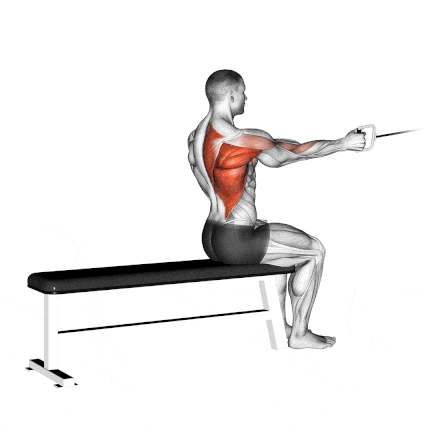
How To Do
- Connect a single-handle attachment to the seated row.
- Sit on the bench and place your feet on the footplates.
- Grasp the D-handle with your right hand with a neutral grip (palm facing inwards).
- Bend your right elbow to pull the handle in towards your right side. You should feel a small squeeze between your shoulder blades.
- You may keep your back straight or gently allow it to sway back and forth in a controlled manner.
- Extend your arm and return to the starting position.
- Complete the specified number of repetitions on the same side and then switch the side.
11. Cable Twisting Standing Row
This exercise uses a lot of muscles because you have to turn your waist a little bit. Due to this being a unilateral cable exercise, you will need to engage your core throughout the movement.
You can use this same exercise with different hand placements to target upper or lower back muscles.
Besides being a great cable back exercise, this movement also works your hips, glutes and other lower body muscles.
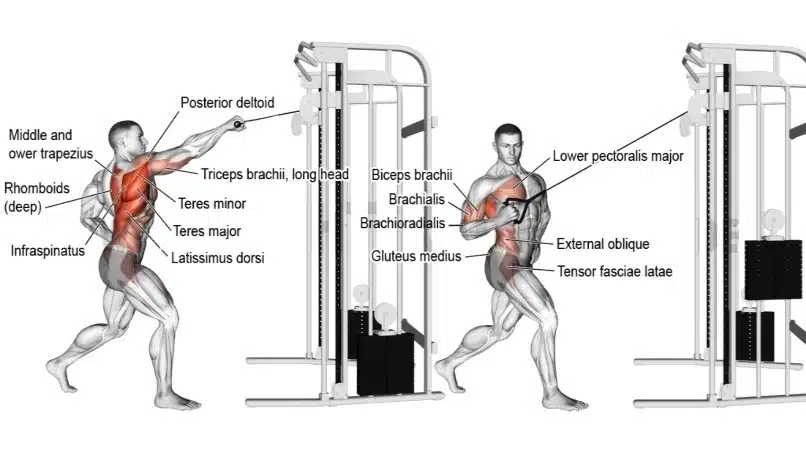
How To Do
- Attach a single grip handle to an elbow-high cable pulley.
- Step back and get into a staggered stance, knees slightly bent.
- Your arm should be out straight, and your waist should be rotated towards the cable.
- Make sure the rotation is in your waist, not your hips.
- Keep your elbow close to your body, and pull back towards your waist while rotating your waist in the same direction.
- Pause briefly at the movement’s top, then slowly return to the starting position.
- Repeat desired reps.
12. Bent Over One Arm Cable Pull
If you’re looking for a way to get more creative with your cable back workout, why not try a bent-over one-arm cable pull?
It is an isolation exercise that builds muscle and strength in the latissimus dorsi muscles of the back. It also targets the lower back and core muscles.
However, since it’s an isolation exercise, it’s recommended to use moderate weights to effectively stimulate the muscle by feeling it contract during each repetition.
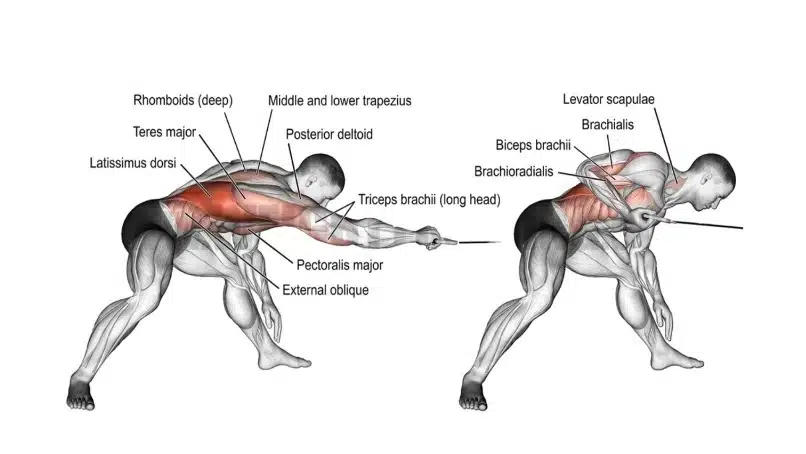
How To Do
- Set up the cable pulley at the bottom of the cable machine. Grasp the handle with one hand.
- Flex your hips and knees until your torso is horizontal.
- Your arm and shoulder should be stretching forward.
- Keeping your elbow close to your body, exhale as you pull the stirrup to the side of your chest.
- Hold for a count of two and squeeze your back muscles.
- Inhale as you reverse the motion and return the stirrup to the starting position, with your arm and shoulder stretching forward.
- Repeat for the ideal number of reps to complete the set.
- Now, switch arms to complete the exercise on your right side, and then alternate between arms for sets.
13. Cable Upright Row
The cable upright row targets many of the large muscles in the upper back and shoulders, which is key for many movements in strength, power, and fitness sports.
Research shows that the upright row is one of the best exercises for building shoulder strength and stability.
Cable machines keep tension on the muscles throughout the entire range of motion, ultimately increasing muscle activation and hypertrophy.
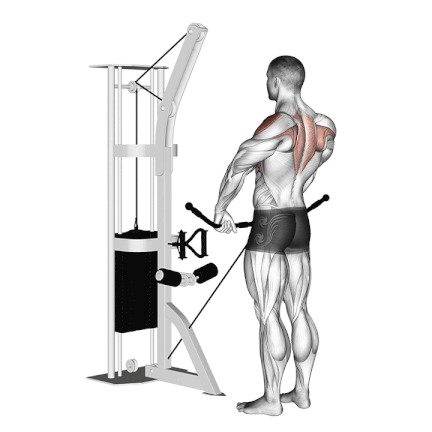
How To Do
- Attach a straight bar to a low cable pulley.
- Grab the bar using a shoulder-width or wider overhand grip.
- Stand close to the pulley with your body upright, your shoulders pulled back.
- Exhale as you pull the bar up the front of your body until it reaches your lower or middle chest level.
- Do not pull the bar up any higher. Hold for a count of two.
- Inhale as you lower the bar to the starting position.
14. Cable Shrug
The cable shrug is a variation of the shoulder shrug and one of the best exercises that are utilized to build the trapezius muscle of the upper back.
It’s one of the best cable exercises for isolating the traps and offers versatility to improve development further.
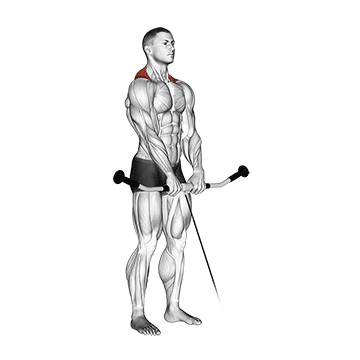
How To Do
- Grab a cable bar attachment that is attached to a low pulley.
- Your hands should be shoulder-width apart or slightly wider if you wish. Your hands should be facing down.
- Stand close to the pulley and extend your arms in front of you while holding the bar.
- Raise your shoulders and lift the bar as high as you possibly can.
- Exhale while performing this movement. Hold the contraction at the top for a second.
- Slowly lower the bar to its starting position.
15. Cable Pullover
The lying cable pullover is a great alternative to the barbell or dumbbell pullover.
It is the best exercise for building a strong rib cage and serratus anterior muscle, which is necessary for building a complete chest and back.
Pullover work directly on the serratus anterior muscle to develop the back.
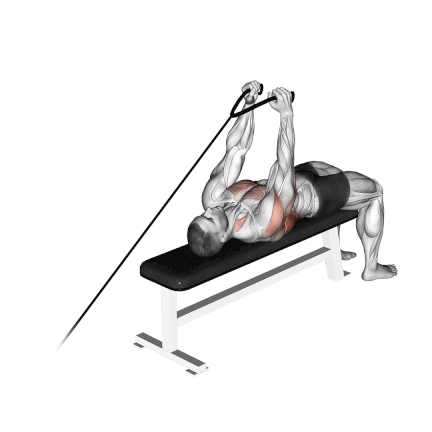
How To Do
- Set up the bench in front of a low pulley cable machine and leave about 2-3 feet between the bench and the machine.
- Lay down on the bench on your back with your head up near the end closest to the cable machine.
- Grasp a rope with both hands.
- Keep your arms straight and slowly pull your hands up and across the top of your head.
- Pause, and then lower the weight back to the starting position.
- Repeat for desired reps.
16. Cable High Row
Half-kneeling high cable row rope is a tremendous exercise that effectively works many muscles, including the shoulder, back, wing, and trapezius muscles.
This exercise gives people with shoulder issues an exercise to benefit from rows.
In addition, face pull is one of the most effective corrective exercises that help compensate for poor posture and shoulder dysfunction.
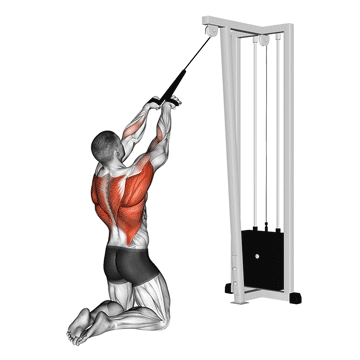
How To Do
- Set the cable up at a high point with the rope attachments
- Grab the rope with both hands using an overhand grip.
- Then take a step back and get onto knees, facing the cable machine
- Starting with your arms stretched out and away, pull back through your elbows until your hands are just in front of your shoulders
- Slowly return to the starting position. Repeat for desired reps.
17. Reverse Cable Crossover
The reverse cable crossover exercise is another great option to help you target the back and grow your back.
Your arms should move directly back (and downward slightly), almost parallel to the floor, to target the rear deltoid, rhomboid, and trap.
Crossing your hands over one another (uncrossing the cables) at the start position increases the range of motion.

How To Do
- Set the pulleys of a cable machine to the lowest position and attach D-handles to each side.
- Stand in the middle of the cable machine, facing away from the machine.
- Grasp the D-handles with your palms facing forward (pronated grip).
- Start with your arms extended straight in front of you, maintaining a slight bend in your elbows.
- Keep your back straight and shoulders relaxed, and pull the handles apart and back in a wide arc.
- Focus on squeezing your shoulder blades together as you bring your hands towards the sides of your body.
- Slowly return to the starting position in a controlled manner.
- Exhale as you pull the handles apart and inhale as you return to the starting position.
18. Face Pull
The face pull primarily targets the rear deltoid and, to a lesser degree, also targets the biceps and traps.
This exercise prevents muscular imbalance and builds overall shoulder strength.
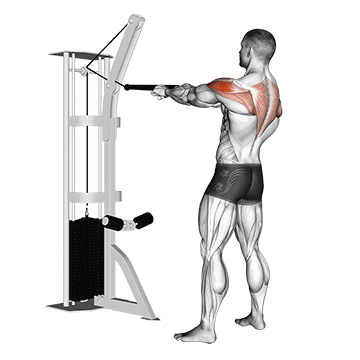
How To Do
- Grab the ends of the rope attachment using a neutral grip (palms facing each other) and slightly lean back.
- Pull the rope toward your face as you spread the ends of the rope, so they end up on the sides of your ears just above your shoulders in the finish position.
- Be sure to exhale when pulling weight toward your face.
- Hold this position for a second as you squeeze your shoulder blades together, contracting rear delts and middle traps as hard as possible.
- Then, slowly return the rope to the start position and repeat for reps.
19. Low Cable Row
The low cable row is an upper body exercise that primarily targets the middle and upper back muscles, including the latissimus dorsi, rhomboids, trapezius, and rear deltoids. Additionally, it works on the arms and shoulders.
It is done using a cable machine with an adjustable pulley at a lower position.
The exercise involves pulling the cable towards your body while keeping a straight back and engaging your core muscles.
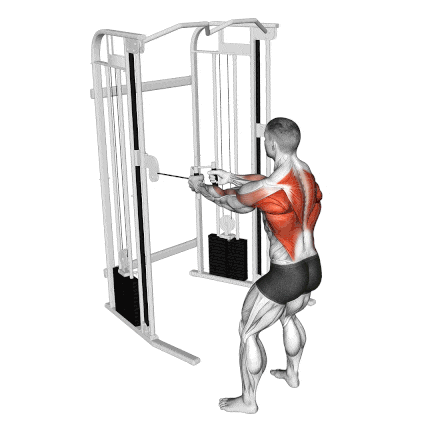
How To Do
- Grab the rope with both hands, step back, and let your arms extend out.
- Bend slightly at the knees and waist to help stabilize yourself.
- Pull the handle towards your midsection, squeezing your shoulder blades together as you do so.
- Pause for a moment, and then slowly release the handle.
- Repeat for the desired number of reps.
20. Cable Deadlift
The cable deadlift is the best variation of the classic barbell deadlift and one of the best cable exercises for the lower back (posterior chain).
The deadlift exercise can be performed using a barbell, a pair of dumbbells, and a cable.
One of the biggest benefits of using cable for deadlifts is that it offers a smooth, controlled motion and gives your muscles almost uninterrupted time under tension, and massive pump — each of which can help optimize muscle growth.
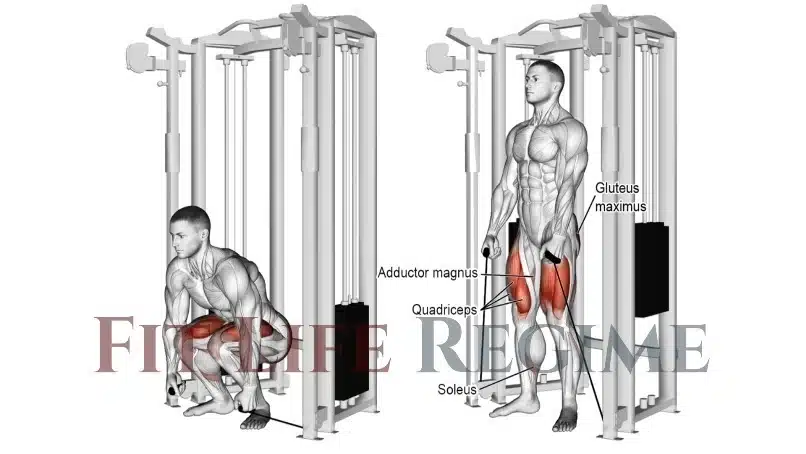
How To Do
- Attach two pulleys at the lowest setting on a cable machine.
- Make sure the cable pulley attachments are located close to each other.
- Holding on to the cable with each hand, you’ll lower your butt to the ground.
- Remember to keep your back as straight as possible. Contract your back and hamstrings.
- Raise the cable using your hamstrings and glutes.
- You should keep your legs slightly bent, your back straight, and your head looking up.
- Raise it to the point where your body is erect.
- Do not hyperextend your body as the weight shifts to the lumbar spine.
- Then, lower the cable slowly at a steady, slow pace by bending at the hips and then at the knees.
Complete Back workout with Cable
Effective back training should incorporate various exercises and target all the major back muscles.
For a complete back workout and to build balanced strength, you’ll need various back exercises that specifically target your upper, middle, and lower back muscles.
- For the lower back, you can do exercises like cable deadlifts and bent-over cable rows to strengthen the posterior chain.
- For middle back, focus on exercises where your hands are closer together, like close-grip rows.
- The upper back can be done with exercises like wide grip rows, single-arm bent-over rows, and upright rows.
- The trap muscles can be done with a cable shrug and an upright cable row.
Cable Machine Back Exercises (With Workout Routines)
Using the cable machine, you can hit all area of back muscles from different angles and through a range of motions.
You can also change body positioning, weight load, and attachments used, which can alter your grip and thus target your muscles differently.
To structure an effective back workout with a cable machine to increase mass and strength, the number of reps and sets will vary based on your fitness level, weekly workout frequency, and strength training goals.
1. Weekly Training Sets
Of course, the number of sets will be determined based on your fitness journey, but here is a great starting point:
- Beginners: ~10 sets per week.
- Intermediate: ~15 sets per week.
- Advanced: ~20 sets per week.
When a certain amount of volume stops being effective and your progress stalls, you can add sets to increase volume and use that as a driver of renewed progress.
2. Select Reps Range Based On Fitness Goals
- For strength gains, do 3 to 6 reps with a weight that is at least 85% of your one-repetition maximum (1RM) The fewer reps you perform, the closer to 100% of your 1RM you should strive for.
- If your goal is hypertrophy (muscle growth), perform 8 to 12 reps., using loads 70 to 85% of your 1RM.
- When training for endurance, it is usually recommended to use higher reps (15 to 20 repetitions) and moderate loads, with a weight at least 50 to 70% of your 1RM.
To be effective, the load should bring you to or near failure within the given rep ranges.
Beginner Back Workout Routine
| Exercise | Sets | Reps | Rest |
|---|---|---|---|
| Lat Pull Down | 3-4 | 8-15 | 60-90 sec |
| Seated Cable Rows | 4 | 8-12 | 60-90 sec |
| Straight Arm Lat Pull Down | 3 | 8-10 | 60-90 sec |
Intermediate Back Cable Workout Plan
| Exercise | Sets | Reps | Rest |
|---|---|---|---|
| Wide Grip Seated Row | 3-4 | 8-12 | 60 sec |
| V-Grip Lat Pull Down | 4 | 6-8 | 60 sec |
| Seated One Arm Cable Row | 3 | 8-12 | 60 sec |
| Straight Arm Rope Pull Down | 3 | 8-10 | 60 sec |
Advance Back Workout plan
| Exercise | Sets | Reps | Rest |
|---|---|---|---|
| Cable Deadlift | 4 | 6-8 | 90 sec |
| One-Arm Lat Pull-Down | 4 | 8-10 | 60 sec |
| Cable High Row: | 3-4 | 8-12 | 60 sec |
| Seated Cable Rows | 3-4 | 8-12 | 60 sec |
| Cable Upright Row | 3 | 8-10 | 60 sec |
Back Anatomy
Your back has many muscles. These muscles help you move your body, including your head, neck, shoulders, arms and legs.
Your back muscles work together to allow you to bend over, twist, turn your head and extend your back.
They also help you carry out everyday actions, like picking up a cup or opening a door.
The muscles of the back can be divided into three groups – superficial, intermediate and deep:
- Superficial — associated with movements of the shoulder.
- Intermediate — associated with movements of the thoracic cage.
- Deep — associated with movements of the vertebral column.
The superficial back muscles are situated underneath the skin and superficial fascia. The muscles in this group are:
- Latissimus dorsi (lats), the largest muscle in the upper part of your body. It starts below your shoulder blades and extends to your spine in the lower part of your back.
- Levator scapulae, a smaller muscle that starts at the side of your neck and extends to the scapula (shoulder blade).
- Rhomboids, two muscles that connect the scapula to the spine.
- Trapezius (traps): These muscles start at the neck, go across the shoulders, and extend to a “V” in the lower back.
The erector spinae is a deep back muscle that starts from the lower spine and extends up to the neck. It is responsible for extending and rotating the spine. The erector spinae is a key part of the lower back and keeps the body working well.
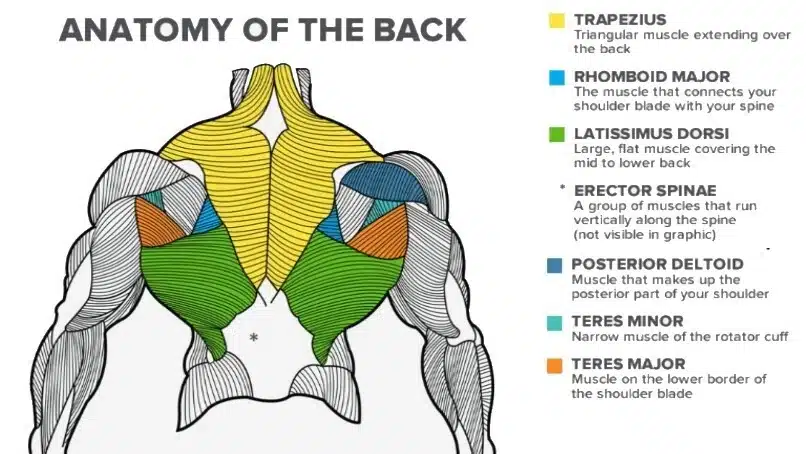
Are cable exercises good for back training?
At any gym, you will find the biggest and inexperienced guys using cable machines for back exercises. Cable machines are very versatile and can be used by everyone.
Cable exercises for the back are good for building muscle and strength in the back muscles. The cables help with smooth movement when doing back exercises with various weights, attachments, body positions, and angles.
The number one reason why cable machines are great for back exercises is that they give continuous tension. Because cable machines apply tension to the muscles during the eccentric and concentric portions of each exercise, they may be more effective than free weights.
Thanks for reading, enjoy working your workout!
Stay Fit, Live a Happy and Healthy Life
References
- Schoenfeld, Brad MSc, CSCS; Kolber, Morey J PT, PhD, CSCS; Haimes, Jonathan E BS, CSCS: The Upright Row: Implications for Preventing Subacromial Impingement. Strength and Conditioning Journal: October 2011 – Volume 33 – Issue 5 – p 25-28
- Cools AM, Witvrouw EE, Declercq GA, Danneels LA, Cambier DC. Scapular muscle recruitment patterns: Trapezius muscle latency with and without impingement symptoms. Am J Sports Med 31: 542–549, 2003.
- Int J Environ Res Public Health. Trapezius muscle timing during selected shoulder rehabilitation exercises. 2021 Jun 14;18(12):6444. doi: 10.3390/ijerph18126444.PMID: 34198674
- Lorenzetti S, Dayer R, Pluss M, List R. Pulling exercises for strength training and rehabilitation: movements and loading conditions. J Funct Morphol Kinesiol. 2017;2(3):33. doi:10.3390/jfmk2030033
- Chad M J Fenwick, Stephen H M Brown, Stuart M McGill. Comparison of different rowing exercises: trunk muscle activation and lumbar spine motion, load, and stiffness. PMID: 19620925 DOI: 10.1519/JSC.0b013e3181b07334
- Jett, David Michael Jr. M.S., C.S.C.S., EP-C, PN; Gibb, Jessica M.S., CEP, EP-C, FMSC; Verrill, David E. M.S., RCEP, CEP, PD, FAACVPR. Evidence-based Alternatives To Popular Exercises. ACSM’s Health & Fitness Journal: November/December 2017 – Volume 21 – Issue 6 – p 20-26

Manish is a NASM-certified fitness and nutrition coach with over 10 years of experience in weight lifting and fat loss fitness coaching. He specializes in gym-based training and has a lot of knowledge about exercise, lifting technique, biomechanics, and more.
Through “Fit Life Regime,” he generously shares the insights he’s gained over a decade in the field. His goal is to equip others with the knowledge to start their own fitness journey.

Nice INformation
Thanks..